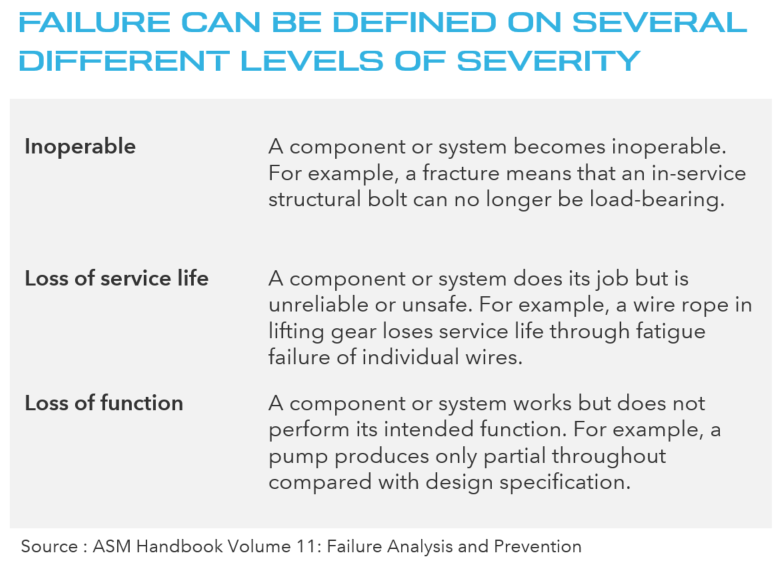Getting to know the many faces of failure
Failure of materials in equipment, piping, structures and associated facilities in plants and on vessels could lead to severe health, safety and environmental consequences. Defining the degree of failure, as illustrated below, helps to determine approaches that can be taken to investigating why the failure has occurred and how to prevent it in the future.

Failure of engineering materials usually manifests as specific physical damage. There are many ways to categorize failure damage to help prioritize methods of investigation. Failure analysts most commonly use four general descriptions of failure mechanisms: fracture, corrosion, wear, and distortion (or undesired deformation).
Understanding the root cause of materials failure is vital
Failure analysis is a proven and vital discipline for finding physical root causes so action can be taken to avoid a problem reoccurring. Analysis is complex, involving several observation, inspection and laboratory techniques. The scope of failure analysis could lead to determining a correctable root cause of failure. Applying principles of Root Cause Analysis (RCA) may ensure that the root cause is understood along with what corrective actions would be appropriate. Effective RCA often requires an interdisciplinary approach. Its objectives determine how deeply it goes into the root causes. It may take place at three levels based on the complexity of the situation and the risk of a failure happening again, as described below.
Three levels of Root Cause Analysis1
Physical roots: The roots of equipment problems are where many failure analyses end. They are often identified by laboratory investigation or engineering analysis. Systematic analysis of equipment failure reveals physical root causes that fall into one of four fundamental categories. These are design deficiencies; materials defects; manufacturing/installation defects; and/or service life anomalies.
Human roots: This identifies human factors that caused or contributed to the failure.
Latent roots: Looking at human error can lead to identifying latent (hidden) roots that are organizational or procedural in nature. They may also be environmental or other roots that are beyond the realm of control.
Applying global expertise to failure investigation
To be properly performed, failure analysis and RCA usually require the involvement of multi-disciplinary experts with an unbiased perspective of the failure. They often need access to various failure analysis tools including well-established laboratories that are experienced in handling such investigations.
Four things you should do when a component has failed
✔ Start collecting evidence immediately: We advise you to gather as much information about failure as possible as soon after it happens. The evidence may be in varying file formats from photos, videos and other logs. Parts should usually not be disassembled and cleaned prior to engaging with failure analysis experts. Another step is to take pictures before and after any required operations.
✔ Contact your nearest DNV failure analysis laboratory for advice: Our specialized laboratories for failure analysis in Norway (Bergen and Oslo), Singapore, UK (Loughborough), and US (Columbus, Ohio) can advise you on the necessary steps to provide and handle failure evidence securely. Our specialists will use documentation that you have provided in several formats to help clarify what has happened.
✔ Consider a specialist site visit: Our specialist team of failure analysis experts can travel to the designated failure site to gather information and conduct part of the investigation there.
✔ Arrange a laboratory investigation: We advise that any critical parts are then secured for shipment to one of our failure laboratories for detailed analysis.
What happens after that?
After conducting site/lab investigations, we work with our customers to determine the root cause of the failure. Our experts can provide in-depth technical advice to prevent future failure on similar components. DNV’s global network of expertise provides a resource pool needed to ensure that failure analysis or RCA is performed properly with the goal of identifying correctable root causes.
Reference:
1. ASM Handbook Volume 11 : Failure Analysis and Prevention, W.T. Becker and R.J. Shipley, ASM International, 2002





